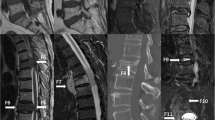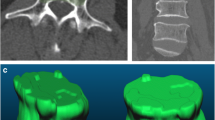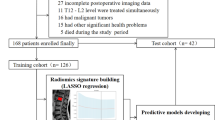Abstract
Objectives
To explore an optimal machine learning (ML) model trained on MRI-based radiomic features to differentiate benign from malignant indistinguishable vertebral compression fractures (VCFs).
Methods
This retrospective study included patients within 6 weeks of back pain (non-traumatic) who underwent MRI and were diagnosed with benign and malignant indistinguishable VCFs. The two cohorts were retrospectively recruited from the Affiliated Hospital of Qingdao University (QUH) and Qinghai Red Cross Hospital (QRCH). Three hundred seventy-six participants from QUH were divided into the training (n = 263) and validation (n = 113) cohort based on the date of MRI examination. One hundred three participants from QRCH were used to evaluate the external generalizability of our prediction models. A total of 1045 radiomic features were extracted from each region of interest (ROI) and used to establish the models. The prediction models were established based on 7 different classifiers.
Results
These models showed favorable efficacy in differentiating benign from malignant indistinguishable VCFs. However, our Gaussian naïve Bayes (GNB) model attained higher AUC and accuracy (0.86, 87.61%) than the other classifiers in validation cohort. It also remains the high accuracy and sensitivity for the external test cohort.
Conclusions
Our GNB model performed better than the other models in the present study, suggesting that it may be more useful for differentiating indistinguishable benign form malignant VCFs.
Key Points
• The differential diagnosis of benign and malignant indistinguishable VCFs based on MRI is rather difficult for spine surgeons or radiologists.
• Our ML models facilitate the differential diagnosis of benign and malignant indistinguishable VCFs with improved diagnostic efficacy.
• Our GNB model had the high accuracy and sensitivity for clinical application.




Similar content being viewed by others
Abbreviations
- AUC:
-
Area under the ROC curve
- DT:
-
Decision tree
- FN:
-
False negative
- FP:
-
False positive
- FS:
-
Fat suppression
- GB:
-
Gradient-boosting decision tree
- GLCM:
-
Gray level co-occurrence matrix
- GLRLM:
-
Gray level run length matrix
- GLSZM:
-
Gray level size zone matrix
- GNB:
-
Gaussian naïve Bayes
- ICCs:
-
Inter- and intraclass correlation coefficients
- KNN:
-
K-nearest neighbor
- LD:
-
Linear discriminant
- LR:
-
Logistic regression
- ML:
-
Machine learning
- MLP:
-
Multilayer Perceptron
- MRI:
-
Magnetic resonance imaging
- PACS:
-
Picture archiving and communication system
- PET/CT:
-
Positron emission tomography/computed tomography
- ROC:
-
Receiver operating characteristic
- ROI:
-
Region of interest
- ROI:
-
Region of interest
- T2WI:
-
T2-weighted imaging
- TN:
-
True negative
- TP:
-
True positive
- VCFs:
-
Vertebral compression fractures
References
Cicala D, Briganti F, Casale L et al (2013) Atraumatic vertebral compression fractures: differential diagnosis between benign osteoporotic and malignant fractures by MRI. Musculoskelet Surg 97(Suppl 2):S169-179
Arevalo-Perez J, Peck KK, Lyo JK et al (2015) Differentiating benign from malignant vertebral fractures using T1 -weighted dynamic contrast-enhanced MRI. J Magn Reson Imaging 42:1039–1047
Chee CG, Yoon MA, Kim KW et al (2021) Combined radiomics-clinical model to predict malignancy of vertebral compression fractures on CT. Eur Radiol 31:6825–6834
Li K, Huang L, Lang Z et al (2019) Reliability and validity of different MRI sequences in improving the accuracy of differential diagnosis of benign and malignant vertebral fractures: a meta-analysis. AJR Am J Roentgenol 213:427–436
Shanbhogue K, Tong A, Smereka P et al (2021) Accelerated single-shot T2-weighted fat-suppressed (FS) MRI of the liver with deep learning-based image reconstruction: qualitative and quantitative comparison of image quality with conventional T2-weighted FS sequence. Eur Radiol 31:8447–8457
Sung JK, Jee WH, Jung JY et al (2014) Differentiation of acute osteoporotic and malignant compression fractures of the spine: use of additive qualitative and quantitative axial diffusion-weighted MR imaging to conventional MR imaging at 3.0 T. Radiology 271:488–498
Tokuda O, Hayashi N, Taguchi K, Matsunaga N (2005) Dynamic contrast-enhanced perfusion MR imaging of diseased vertebrae: analysis of three parameters and the distribution of the time-intensity curve patterns. Skeletal Radiol 34:632–638
Jung HS, Jee WH, McCauley TR, Ha KY, Choi KH (2003) Discrimination of metastatic from acute osteoporotic compression spinal fractures with MR imaging. Radiographics 23:179–187
Grassi R, Lombardi G, Reginelli A et al (2007) Coccygeal movement: assessment with dynamic MRI. Eur J Radiol 61:473–479
Muto M, Perrotta V, Guarnieri G et al (2008) Vertebroplasty and kyphoplasty: friends or foes? Radiol Med 113:1171–1184
An HS, Andreshak TG, Nguyen C, Williams A, Daniels D (1995) Can we distinguish between benign versus malignant compression fractures of the spine by magnetic resonance imaging? Spine (Phila Pa 1976) 20:1776–1782
Ishiyama M, Fuwa S, Numaguchi Y, Kobayashi N, Saida Y (2010) Pedicle involvement on MR imaging is common in osteoporotic compression fractures. AJNR Am J Neuroradiol 31:668–673
Theodorou DJ (2001) The intravertebral vacuum cleft sign. Radiology 221:787–788
Nie P, Yang G, Wang N et al (2021) Additional value of metabolic parameters to PET/CT-based radiomics nomogram in predicting lymphovascular invasion and outcome in lung adenocarcinoma. Eur J Nucl Med Mol Imag 48:217–230
Frighetto-Pereira L, Rangayyan RM, Metzner GA, de Azevedo-Marques PM, Nogueira-Barbosa MH (2016) Shape, texture and statistical features for classification of benign and malignant vertebral compression fractures in magnetic resonance images. Comput Biol Med 73:147–156
Mauch JT, Carr CM, Cloft H, Diehn FE (2018) Review of the imaging features of benign osteoporotic and malignant vertebral compression fractures. AJNR Am J Neuroradiol 39:1584–1592
Wennmann M, Thierjung H, Bauer F et al (2022) Repeatability and reproducibility of ADC measurements and MRI signal intensity measurements of bone marrow in monoclonal plasma cell disorders: a prospective bi-institutional multiscanner, multiprotocol study. Invest Radiol 57:272–281
Wennmann M, Bauer F, Klein A et al (2022) In vivo repeatability and multiscanner reproducibility of MRI radiomics features in patients with monoclonal plasma cell disorders: a prospective bi-institutional study. Invest Radiol 58:253–264
Da-Ano R, Visvikis D, Hatt M (2020) Harmonization strategies for multicenter radiomics investigations. Phys Med Biol 65:24tr02
Fatania K, Mohamud F, Clark A et al (2022) Intensity standardization of MRI prior to radiomic feature extraction for artificial intelligence research in glioma-a systematic review. Eur Radiol 32:7014–7025
Wennmann M, Klein A, Bauer F et al (2022) Combining deep learning and radiomics for automated, objective, comprehensive bone marrow characterization from whole-body MRI: a multicentric feasibility study. Invest Radiol 57:752–763
Funding
This study has received funding from the National Natural Science Foundation of China (81871804, 82100940) and National Key Research and Development Project (CN) (2019YFC0121400). None of these funding sources had any role in the study design; the collection, analysis, and interpretation of data; the writing of the report; or the decision to submit the paper for publication.
Author information
Authors and Affiliations
Corresponding authors
Ethics declarations
Guarantor
The scientific guarantor of this publication is Xuexiao Ma.
Conflict of interest
The authors of this manuscript declare no relationships with any companies, whose products or services may be related to the subject matter of the article.
Statistics and biometry
One of the authors (Guangjie Yang) has significant statistical expertise.
Informed consent
Written informed consent was waived by the institutional review board.
Ethical approval
Institutional review board approval was obtained.
Study subjects or cohorts overlap
No.
Methodology
• retrospective
• case–control study
• multicentre study
Additional information
Publisher's note
Springer Nature remains neutral with regard to jurisdictional claims in published maps and institutional affiliations.
Rights and permissions
Springer Nature or its licensor (e.g. a society or other partner) holds exclusive rights to this article under a publishing agreement with the author(s) or other rightsholder(s); author self-archiving of the accepted manuscript version of this article is solely governed by the terms of such publishing agreement and applicable law.
About this article
Cite this article
Zhang, H., Yuan, G., Wang, C. et al. Differentiation of benign versus malignant indistinguishable vertebral compression fractures by different machine learning with MRI-based radiomic features. Eur Radiol 33, 5069–5076 (2023). https://doi.org/10.1007/s00330-023-09678-x
Received:
Revised:
Accepted:
Published:
Issue Date:
DOI: https://doi.org/10.1007/s00330-023-09678-x




